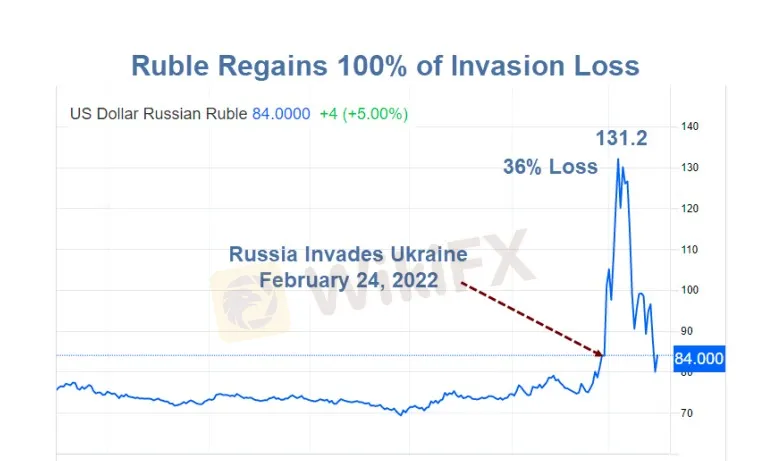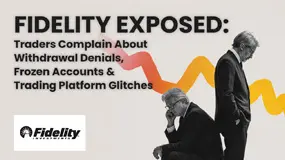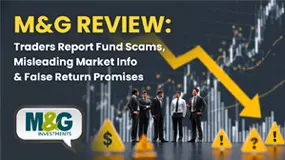简体中文
繁體中文
English
Pусский
日本語
ภาษาไทย
Tiếng Việt
Bahasa Indonesia
Español
हिन्दी
Filippiiniläinen
Français
Deutsch
Português
Türkçe
한국어
العربية
The Ruble Regains 100% of Its Loss After Russia Invaded Ukraine, Why?
Abstract:Conventional wisdom on why the ruble has rallied is simply wrong.
Let's discuss the theories and what is really happening.

Key Points
When Russia invaded Ukraine on February 24, it took 84 rubles to buy 1 US dollar.
On March 7, it took 131.2 rubles to buy 1 US dollar.
That's a 36% decline in the rubble vs the US dollar.
The ruble is now back where it started on February 24.
Conventional Wisdom
Putin and Italy's Prime Minister, Mario Draghi, have discussed payments for gas in Russian rubles.
Weiner correctly notes the imagination.
Oil for Rubles, Who Cares?

Case 1: To get rubles to buy oil, Europe sells Euros to Russia central bank. Europe immediately send the rubles it received straight back to Russia to pay for the the oil. Russia central bank accumulates euros.
Case 2: Russia sells oil for euros. Russia central bank accumulates the exact same number of Euros as in case number one.
The currency exchange takes place in seconds. Europe does not have to hold rubles to buy oil.
This is just more of the “oil priced in euros” stupidity. No one will have to hold rubles to buy Russian oil. Or gas. The Ruble does not become a reserve currency.
There is perhaps some small psychological impact, but there is no real impact unless Europe actually held ruble reserves, and here's a hint: Europe wouldn't.
What About European Sanctions?
Biden says “Ruble reduced to Rubble because of sanctions.”
It took another three days from that Tweet for the ruble to regain all of its losses. Why?
In three words: Sanctions Don't Work. Here are some examples.
Parallel Credit Card Payment System
The Wall Street Journal reports Russia Built Parallel Payments System That Escaped Western Sanctions
Visa and Mastercard pulled the plug on Russia's credit cards. But following the 2014 war in which Visa and Mastercard did the same, Russia took measures to not let that happen again.
Instead, Putin implemented a National Payment Card System—known by its Russian initials NSPK. Visa and Mastercard went along with it.
In 2015 Russia then forced the use of Mir cards based on NSPK.
Those cards do not use the US payment system.
One irony is that instead of Visa and Mastercard getting the fees, Russia's central bank collected 8.2 billion rubles in net profit, or about $94 million at current exchange rates.
Russia actually profited from Visa and Mastercard sanctions.
Disclaimer:
The views in this article only represent the author's personal views, and do not constitute investment advice on this platform. This platform does not guarantee the accuracy, completeness and timeliness of the information in the article, and will not be liable for any loss caused by the use of or reliance on the information in the article.
Read more

Fidelity Exposed: Traders Complain About Withdrawal Denials, Frozen Accounts & Platform Glitches
Does Fidelity Investments prevent you from accessing funds despite numerous assurances on your requests? Do you witness an account freeze by the US-based forex broker every time you request withdrawal access? Do you struggle with an unstable trading platform here? Is the slow Fidelity customer service making you face forced liquidation? These issues haunt traders, with many of them voicing their frustration on several broker review platforms such as WikiFX. In this Fidelity review article, we have shared quite a few complaints for you to look at. Read on!

Exposing The Trading Pit: Traders Blame the Broker for Unfair Withdrawal Denials & Account Blocks
Did you receive contradictory emails from The Trading Pit, with one approving payout and another rejecting it, citing trading rule violations? Did you purchase multiple trading accounts but receive a payout on only one of them? Did The Trading Pit prop firm refund you for the remaining accounts without clear reasoning? Did you face account bans despite using limited margins and keeping investment risks to a minimum? These are some raging complaints found under The Trading Pit review. We will share some of these complaints in this article. Take a look.

M&G Review: Traders Report Fund Scams, Misleading Market Info & False Return Promises
Applying for multiple withdrawals at M&G Investments but not getting it into your bank account? Do you see the uncredited withdrawal funds out of your forex trading account on the M&G login? Does the customer support service fail to address this trading issue? Does the misleading market information provided on this forex broker’s trading platform make you lose all your invested capital? Were you lured into investing under the promise of guaranteed forex returns? These issues have become highly common for traders at M&G Investments. In this M&G review article, we have echoed investor sentiments through their complaint screenshots. Take a look!

INZO Broker MT5 Review 2025: A Trader's Guide to Features, Fees and Risks
INZO is a foreign exchange (Forex) and Contracts for Difference (CFD) brokerage company that started working in 2021. The company is registered in Saint Vincent and the Grenadines and regulated offshore. It focuses on serving clients around the world by giving them access to popular trading platforms, especially MetaTrader 5 (MT5) and cTrader. The company offers different types of trading instruments, from currency pairs to cryptocurrencies. It aims to help both new and experienced traders. Read on to know more about it.
WikiFX Broker
Latest News
2 Malaysians Arrested in $1 Million Gold Scam Impersonating Singapore Officials
Moomoo Singapore Opens Investor Boutiques to Strengthen Community
OmegaPro Review: Traders Flood Comment Sections with Withdrawal Denials & Scam Complaints
An Unbiased Review of INZO Broker for Indian Traders: What You Must Know
BotBro’s “30% Return” Scheme Raises New Red Flags Amid Ongoing Fraud Allegations
The 5%ers Review: Is it a Scam or Legit? Find Out from These Trader Comments
WikiEXPO Dubai 2025 Concludes Successfully — Shaping a Transparent, Innovative Future
Admirals Cancels UAE License as Part of Global Restructuring
Forex Expert Recruitment Event – Sharing Insights, Building Rewards
Exness Broker Expands in South Africa with Cape Town Hub
Currency Calculator



